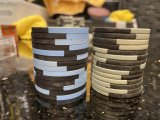Moxie Mike
Full House
I spoke to my good friend who runs Tackett Game Calls about refurbishing some chips on a lathe. His feedback was interesting:
There are a handful of challenges. One is getting all the chips together and perfectly stacked. Another is getting them to stay together while on the lathe. Yet another is getting them perfectly centered between the lathe spindles so they spin true.
We discussed the possibility of some type of temporary, non-residue adhesive (like this maybe?) to hold them together while sandwiching them between a couple of blocks of wood. Getting all the chips centered is still an issue, and the turning process is going to remove quite a bit of material.
All chips will need to be turned to the diameter of the worst one of the bunch. So while they'll likely have varying degrees of wear, they all be machined to the lowest necessary thickness. So some chips will be unnecessarily shrank in the interest of consistency.
As has already been mentioned, achieving uniformity would be difficult from one batch to another. Even if you were somehow able to turn 100 chips at a time, you're almost certainly going to have diameter variances from one rack to the next - and once they were all mixed together it would probably be very noticable.
All that said, he said he'd be willing to try it when hunting season in MI ends. I don't own any chips in poor condition, but if anyone cares to send along some sacrificial lambs, I'll see what we can work out.
There are a handful of challenges. One is getting all the chips together and perfectly stacked. Another is getting them to stay together while on the lathe. Yet another is getting them perfectly centered between the lathe spindles so they spin true.
We discussed the possibility of some type of temporary, non-residue adhesive (like this maybe?) to hold them together while sandwiching them between a couple of blocks of wood. Getting all the chips centered is still an issue, and the turning process is going to remove quite a bit of material.
All chips will need to be turned to the diameter of the worst one of the bunch. So while they'll likely have varying degrees of wear, they all be machined to the lowest necessary thickness. So some chips will be unnecessarily shrank in the interest of consistency.
As has already been mentioned, achieving uniformity would be difficult from one batch to another. Even if you were somehow able to turn 100 chips at a time, you're almost certainly going to have diameter variances from one rack to the next - and once they were all mixed together it would probably be very noticable.
All that said, he said he'd be willing to try it when hunting season in MI ends. I don't own any chips in poor condition, but if anyone cares to send along some sacrificial lambs, I'll see what we can work out.

